Remote working practices are gradually becoming the norm. Even before Covid, workplace communications were much more likely to take place over email than face-to-face. But is problematic in industries where safety is key?
In a recent interview report, Network Rail’s Chief Executive Andrew Haines said: “the industry’s tendency of talking up its brilliant safety culture is often wide of the mark,” and added “there are still too many instances of people on track that are not supervised and where safety lapses and breaches do occur”.
I would add that in some places there are shortcomings due to remote management by email when it needs to be face-to-face and a failure to listen to the concerns of those doing the work.
I recall a time when I had my own safety responsibility statement which required me to carry out unannounced site audits of the work being carried out on track. The minimum number of such safety site visits was specified and those doing the work needed little encouragement in telling me what was wrong and how their work could be improved.
I recall clearly the first time my records were checked and I was formally interviewed following an accident by the then Inspectorate (now part of the Office of the Rail Regulator (ORR). I also remember the many times when my unexpected site visit made me aware of shortcomings and the positive response of the workforce to my visits.
Unable to stop
On 23 December2021 the Rail Accident Investigation Branch (RAIB) issued Safety Digest 08/2021 about the collision that occurred at 10:32 am on 21 September at Grosmont Station on the North Yorkshire Moors Railway (NYMR). A Class 20 diesel electric locomotive entered platform 2 and collided with the back of a passenger train. The Class 20 had been uncoupled from the train from Whitby on platform 3 and was to wait behind the platform 2 train which was due to depart to Whitby some time later.
There were 175 passengers on the waiting train when the Class 20 ran into it. Five suffered minor injuries that were treated by first aiders and although there was some damage to the passenger coaches there were none to the Class 20, track, or infrastructure. The locomotive was travelling too fast and was unable to stop when the coaches came into view. The locomotive only has a cab at one end hence the view forward is restricted when it is driven nose end leading.
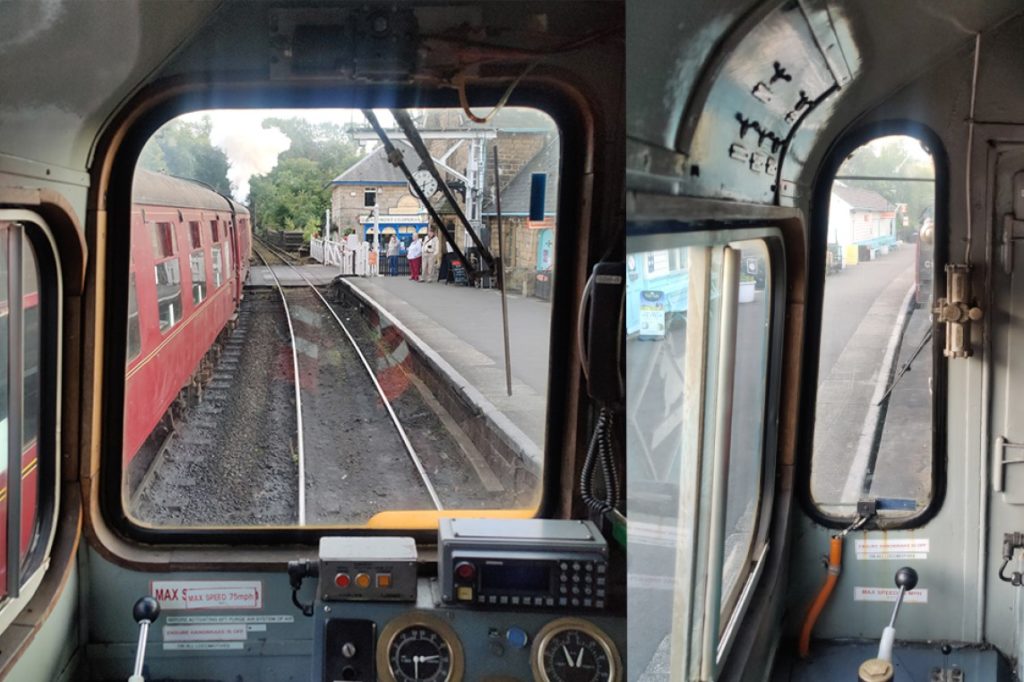
Driver competency
NYMR’s locomotives were undergoing maintenance. Consequently, when the scheduled steam locomotive failed its Automatic Warning System (AWS) test, a privately owned Class 20 was made available. The AWS is a requirement for operating on the Esk Valley line between Grosmont and Whitby. For about five years the driver had held competences covering steam locomotives as well as diesels Class 25 and 37, although he did not have the specific competency for Class 20. Consequently, he sought the assistance of a traction inspector to accompany him.
RAIB’s reconstruction of events showed that the Class 20 driver would only be able to see the rear coach when he was about 16 metres from it! The driver said he was aware of the train on platform 2 but thought there was more space than there was. NYMR was unable to provide documentary evidence that either the driver or traction inspector had Class 20 driving competence; although the inspector had maintained and driven all the locomotives operated by NYMR. On 7 October the ORR issued an improvement notice requiring that NYMR become able to demonstrate driver competencies.
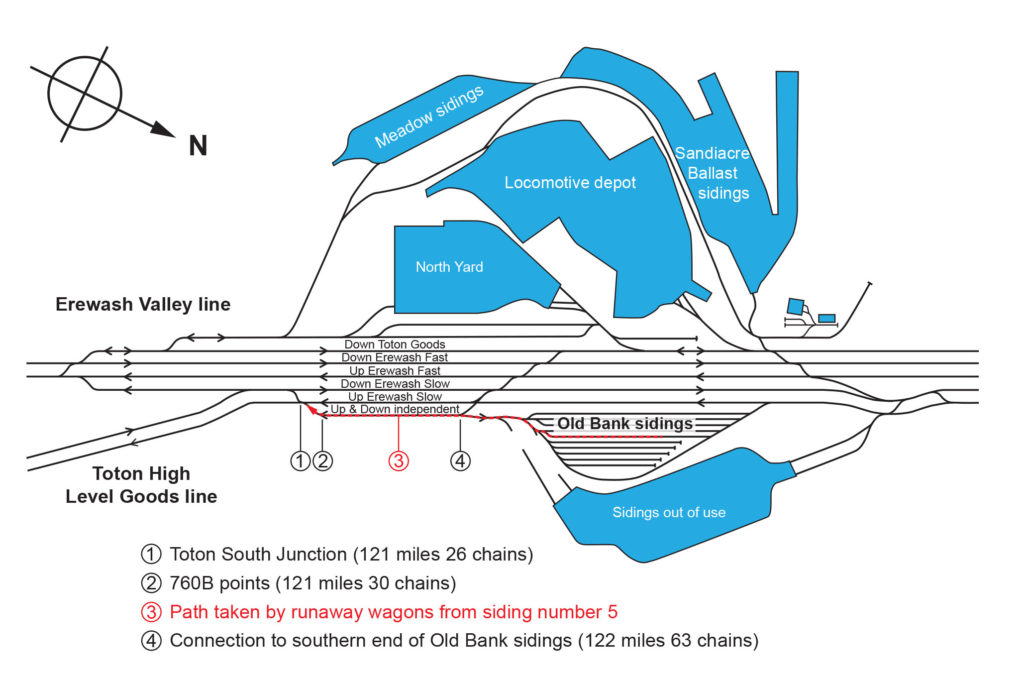
Wagon run away
On 20 December RAIB issued report 09/2021 about the runaway of 22 wagons (21 loaded) at Toton Sidings Nottinghamshire on 17 January last year. The run away began at 04:42 in Old Bank sidings. The wagons passing a red signal alerted a signaller and, after passing a second red light, the leading four wagons derailed leaving the leading two foul of the adjacent running line. The wagons had run away for around a kilometre.
The 22 wagons had not been secured with either handbrakes or scotches when they were stabled the previous evening. Initially they were restrained by the air trapped in their braking systems until it leaked away. They had not been secured in any way before they were uncoupled and there was “miscommunication between the ground staff on duty and about who would secure the train.”
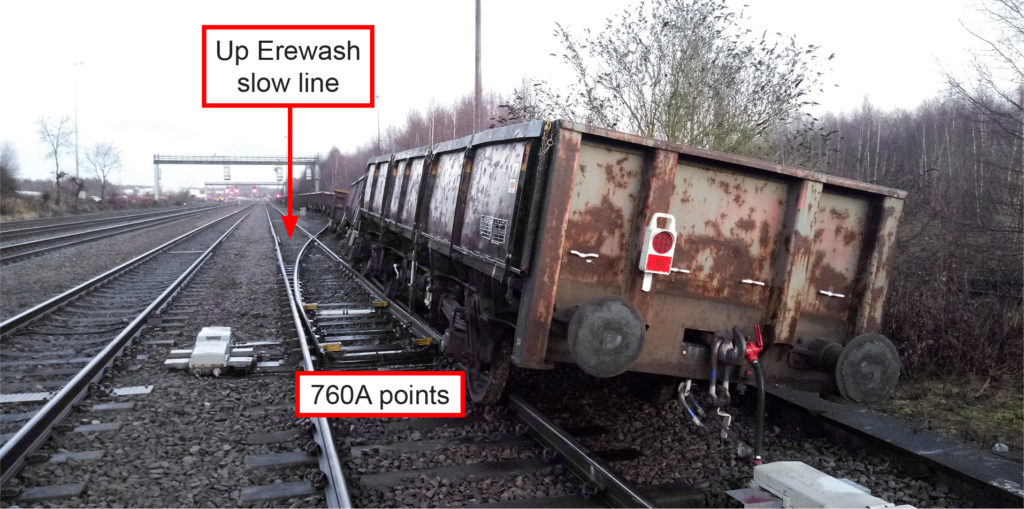
Train unsecured
The report adds that Old Banks Sidings staff were routinely leaving trains unsecured for short periods of time and DB Cargo “had no clear process in place defining the tasks required when trains arrived”. RAIB also found that Network Rail’s risk assessment “only considered mitigations that were not applicable to uncontrolled runaway vehicles.” The RAIB report includes two learning points which refer to reminding staff of the importance of securing vehicles prior to detaching them from locomotives and reminding all concerned that trap points on the exits from sidings exist to protect running lines from runaway vehicles.
The first of four recommendations requires that DB Cargo establish the extent to which vehicles are being left unsecured in its yards and sidings. Second, it required to review processes for trains arriving at their yards, identifying who is responsible and how completion is communicated. Third, it is to review supervision, monitoring and the auditing of safety in yards and sidings, leading to recommendation four which directs Network Rail to revise its risk assessment process for trap points to include the risk of an adjacent running line becoming foul when vehicles run away.
Near miss at Forestry Norfolk UWC
On 13 December RAIB released its Safety Digest about a near miss that occurred on 18 September. At 06:05 the 05:27 Great Anglia train from Norwich to Stansted Airport came close to striking two cars at this User Worked Crossing (UWC) which is between Thetford and Brandon. One car had crossed the tracks when the train passed but had not been able to move away because its driver had not opened the gate on the far side of the crossing. The other car was inside the railway boundary waiting to cross the tracks as the train went by. The CCTV train cab camera shows how near the miss was!
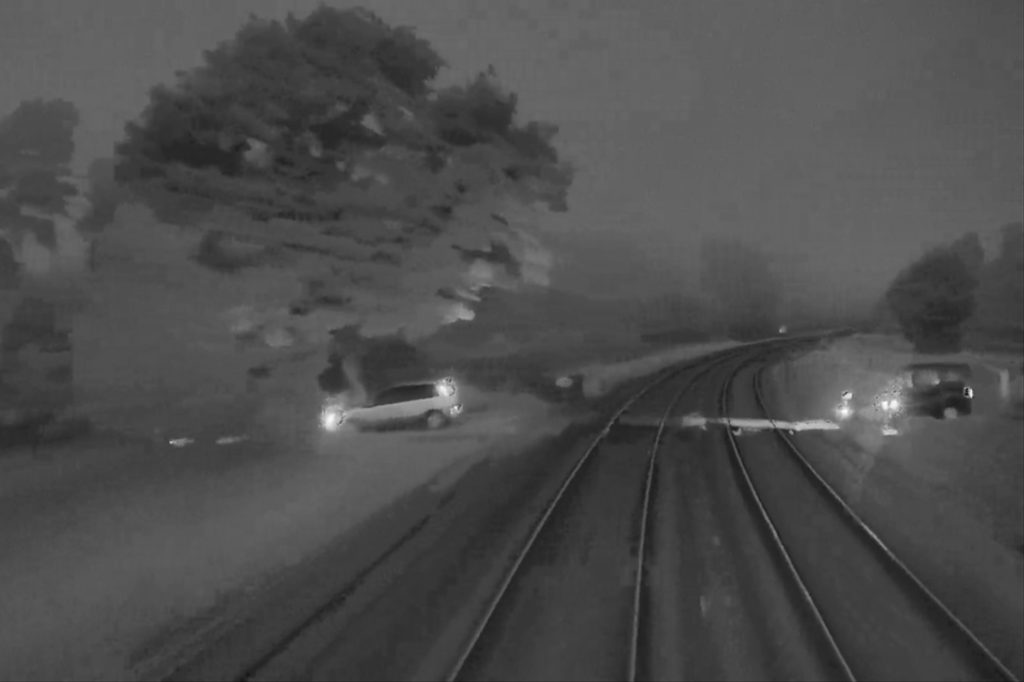
The train was travelling at 76mph which, due to braking, was slowed by just 2mph as it passed over the crossing. The driver’s brake application slowed the train to just 19mph as it reached its scheduled stop at Brandon Station three quarters of a mile beyond Forestry Crossing. It has telephones for road users to speak with the signaller at Thetford Workstation so that permission may be granted for road vehicles to cross. One of the car drivers used the telephone saying he would need just two minutes. Permission was given with the signaller not realising that the train was already approaching the crossing.
Judgement or guesswork?
Thetford workstation has five screens providing a schematic layout display from Wymondham to Shippea Hill. When a train enters the section on screen the line changes from white to red and a label appears showing the reporting number of the train. The Safety Digest comments that the signaller booked on 18 minutes earlier than scheduled to familiarise himself with the activity on the workstation.
It also comments that “the long section between Thetford Station and Forestry UWC did not give the signaller enough information for him to make an informed decision about when it would reach the crossing”. It adds that “there are no formal criteria for making the decision to grant permission to cross, it is a matter of signallers’ judgement and expertise”. Sounds like guess work to me!
The Digest refers to “previous similar occurrences” including Hockham Road (April 2016) resulting in Network Rail being recommended to “review its measures for protecting user worked crossings”. Following the Forestry incident, Network Rail told RAIB that its new procedure is to be published in 2022.
Tram pedestrian fatality
On 24 November last year at 18:10 a Blackpool Tram struck a pedestrian who sustained serious injuries and later died. It happened on a pedestrian crossing within the segregated tramway section beyond the Fleetwood Road/Queens Promenade Road junction in Cleveleys. The pedestrian crossing is not a controlled one.
On leaving Anchorsholme Lane stop the tram headed south towards Starr Gate. CCTV recordings show traffic had stopped to allow the tram to pass over the junction and enter the segregated tram section. RAIB’s investigation will identify the sequence of events, the actions of those involved, the design and configuration of the crossing, how it was risk assessed, legislation, industry guidance, and any underlying factors.
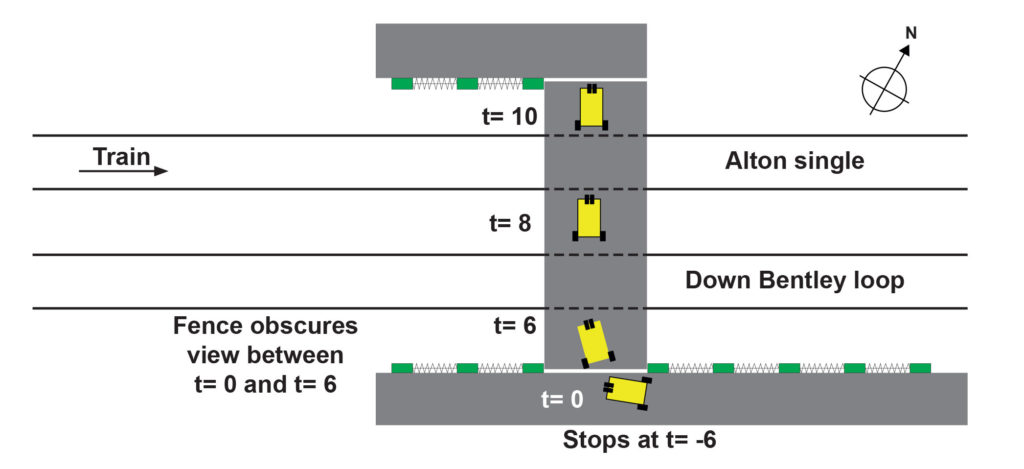
UWC mobility scooter collision
On 22 December RAIB published its preliminary examination of this UWC collision at Burgess Drove,near Waterbeach in Cambridgeshire, which occurred on 9 August last year. Around 14:33 a Great Anglia train passed over the crossing and struck a mobility scooter in the crossing area adjacent to the downside gate. The scooter was damaged but its user was uninjured. RAIB says that the accident happened because the scooter user was not able to complete crossing of the railway line in the time available between the warnings (red light and audible alarm) and the passage of the train.
The user required 100 seconds between opening the first gate and closing the second one, but the approach warning started just 40 seconds before the train reached the crossing. RAIB has decided not to investigate further but its preliminary investigation refers to an accident at Alice Holt level crossing on 5 October 2016 (Reference 14/2017) that led to the recommendation that Network Rail improve guidance to level crossing managers so they can “better assess the risk to vulnerable users including mobile scooter users of level crossings that rely entirely on users looking and listening for trains”.
Burgess Drove has red lights and audible warnings so it is not covered by the recommendation but RAIB has written to Network Rail (copy to the ORR) asking for the recommendation to be extended to cover all UWCs in public use.
Forklift truck overturned
Network Rail’s Safety Central website posted an alert on 23 December following this accident at Holgate depot on 17 December. Three contractors were trying to move a 4.5 tonne steel frame into a building using two forklift trucks: one with a 3 tonne safe working load (SWL) the other with a 13 tonne SWL!
Positioned at the ends of the load and each using a single lifting strap over their forks, they began the lift. As the load started to turn the smaller truck was pushed out of position and overturned. Fortunately, there were no injuries, but an investigation is underway into this RIDDOR reportable accident.
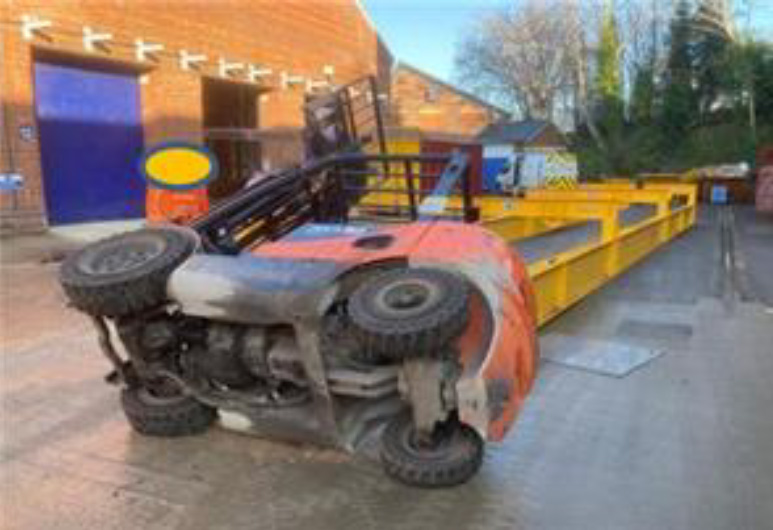
The incidents and accidents listed provide clear evidence of the imperfections of current railway safety culture. The pandemic together with the convenience of electronic communication methods have made face-to-face discussions more difficult. The way ahead to improve safety is for supervisors and management to ensure that they spend at least two days each and every week at work with their operational staff. It can have the added benefit of forcing deputies to make decisions and improve their own abilities.

